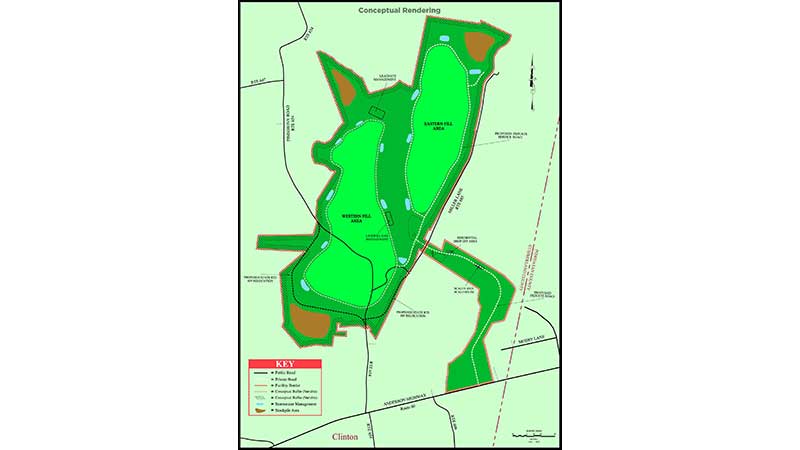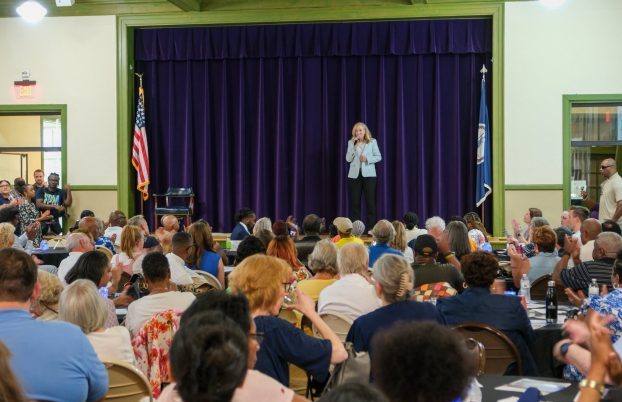What is Green Ridge?
Published 9:41 pm Tuesday, June 5, 2018

- Pictured is a map of the proposed 1,200-acre Green Ridge Facility in the area of Route 685, Miller Lane and Route 654, Pinegrove Road in Cumberland County, near the Powhatan County line. (Photo courtesy of Green Ridge Facility)
Green Ridge Recycling and Disposal Facility is garnering a lot of discussion prior to its community meeting Thursday at 7 p.m. at Cumberland Elementary School. Learn more about the proposed facility and the county’s involvement with the process here.
What is Green Ridge?
Green Ridge is a proposed recycling and waste disposal facility to be located on 1,200 acres off Route 60, in the area of Pinegrove Road and Miller Lane.
Of the 1,200 acres, 500-650 acre will be used as the waste disposal area, which will be separated into a western fill area and an eastern fill area. The majority of the remaining land is set to be used as a buffer. This area, according to the company website, will include a Department of Environmental Quality-permitted composite liner system, which filters out rainwater and discharge from waste. The facility, located by the Powhatan County line, will also feature a recycling center.
Green Ridge is proposed to bring between $1.4 million to $2.8 million a year to the county.
County Administrator and Attorney Vivian Seay Giles said a rezoning application and conditional use application for Green Ridge were submitted May 25.
“Two applications (an application for rezoning and an application for a conditional use permit) were submitted Friday, May 25,” Giles said. “The County is in the early stages of review of these two applications, first by the planning commission prior to the board of supervisors considering the matters.”
The rezoning request spans 15 parcels with 14 currently being zoned as Agricultural-2 and a portion of a parcel zoned as Residential-2. The rezoning request would have the parcels be zoned as M-2, which designates a heavy industrial zone.
The planning commission will meet about the rezoning and conditional use permit June 14, 6:30 p.m. at Cumberland County Elementary School.
Green Ridge will accept between 3,500 and 5,000 tons of waste per day from County Waste of Virginia customers, including household waste, construction and demolition debris and approved industrial waste.
Nearly all waste will be coming from Virginia, though some material may come from County Waste operations in Pennsylvania.
Project Manager Jay Zook said County Waste of Virginia serves approximately 300,000 customers in Central Virginia, Williamsburg area, and in the Fredericksburg and Richmond areas.
“Strategically, this location makes a lot of sense to us as a company to service our locations throughout the state,” Zook said about Cumberland’s location.
“There’s a lot of uncertainty with the landfill capacity within this market area,” Zook said, “and this really gives us a way to ensure that we have a place to serve our customers.”
The facility will not accept any toxic materials, hazardous materials, nuclear waste, drywall board or wastewater treatment sludge, the website and Zook cited.
The estimated life span of the facility will be 35 years, once all of the cells in the eastern and western end of the facility have been filled and capped.
“Once capped and closed it will continue to be monitored and will serve as open green space, with the area not used for waste utilized in a number of ways as determined by the County,” the website noted.
How will the landfill work?
The facility is proposed to be built in two phases, with an eastern fill area, located near the area of Miller Lane being built first, and a western area near the area of Route 654, Pinegrove Road being built later.
Zook and Jay Smith, partner with Richmond-based business and communications consulting firm Capital Results, representing County Waste, said the operators would dig a hole, or cell, at approximately 20 feet deep, placing trash until the cell is filled. Once filled, the cell will be covered with dirt, or capped. Zook said this process can take one to two years. Zook said what’s put into the cell is specific, starting with soft material such as household waste items on the bottom and moving up to construction and demolition debris.
To prevent runoff of materials, each cell would be lined with what’s called a composite liner system, which would line the cell and collect any sludge or water that might accumulate, which is known as leachate.
The liner could almost be considered similar to the role of a liner in a trashcan, except the liner material in the landfill is much stronger. Zook said the liner is 60 mil thick.
He said each cell will have pipes that will collect leachate. Leachate is collected by the pipes and transported into a tank, where it is shipped to another facility to be treated. Zook and Smith said the pipes will collect the leachate continually, which could also help eliminate odor commonly found at landfills.
Zook and Smith said as the process of filling the cells continues, the operators will begin to collect methane, a gas that comes from decomposition of waste.
They said with enough methane, the gas could be converted into electricity, which could potentially be used to operate a small power plant.
They said representatives with the facility will monitor and collect methane gas and install monitoring wells that will surround each of the cells to make sure they can detect and treat runoffs of wastes.
The location of the Green Ridge facility is different from the site of a previously approved Republic landfill.
Zook said the majority of activity that includes trucks entering the facility, more than 50 percent, will take place after peak hours between midnight to 5 a.m. He said the facility uses low-impact lighting and will have motion detection systems on trucks so that they won’t beep unless they sense an object behind them.
They said the life span of the facility would be approximately 35 years, the time it would take to fill all of the cells that would fit into the eastern and western side of the property at a rate of 3,500 to 5,000 tons of waste a day.
They said once the facility is closed, the county could potentially use the land for recreational purposes such as trails.
How will this affect nearby residents?
Zook said the western side would potentially run through Route 654, Pinegrove Road and Route 685, Miller Lane, would potentially run through the border of the landfill. Smith and Zook said there may be plans to relocate the two routes as construction progresses.
The facility noted on its website that it would construct new turn lanes at the intersection of State Route 60, and a new private mile long access road connecting the facility with the highway. Zook and Smith said this would prevent trucks entering the facility from backing up in the road. Green Ridge would front the cost of the construction of the turn lanes, the website said.
Residents have long suspected a proposed landfill coming to the county, citing seeing drilling activity near their property and finding documentation at the county courthouse that seemed to indicate a developing project. The proposed landfill has been a topic of discussion for several months as residents urged the county to show transparency and notify residents if a project was underway.
According to a copy of Cumberland County Property Transfers from October 2017 that were published in The Farmville Herald, two parcels of land in the Hamilton district were transferred to CWV Land Acquisition LLC. The properties, cited to belong to Clarke Chastain Jones, et als, came to the amounts of $793,072 and $58,305 respectively. The four parcels included in the two properties are 36.09 acres, 63.54 acres, 120.76 acres and 17.94 acres respectively. Records obtained by the Cumberland County Circuit Court office and Commissioner of Revenue office cited a deed made to James W. Tinsley III from CWV Land Acquisition LLC on Nov. 30, 2017, noted that the land parcel contains 43.5 acres at the east side of State Route 654.
Hubbard Sprouse, a speaker at a March Cumberland Board of Supervisors meeting, said in a phone interview that he became heavily involved with the progress of a proposed landfill in the county several years ago. He said he first heard rumors of a potential landfill in the area of Pinegrove Road after hearing the rumor from a neighbor. He said he saw equipment on one of the “wooded” roads, or small roads that lead to private property. “There was some equipment there,” Sprouse said, “and it wasn’t any kind of equipment you would use to dig the 4 or 6 foot hole to test for septic systems and that sort of thing, this was serious drilling equipment.” He said he saw the company CWV Land Acquisitions, LLC when paging through records at the court, with the help of an employee at the office.
He was one of several speakers who expressed frustration during the March Board of Supervisor discussion of the county’s refuse hauling service bids, which could potentially change how trash collection is operated in the county. “It upset me that the people that represent you, like the board of supervisors, doesn’t come out and ask ‘what do you think about it?’ or ‘this is coming up,’” Sprouse said. “That is what I was trying to convey at the board of supervisors meeting that you’re representing your people, and how can you represent the people if you don’t know what the people want?”
Sprouse said a potential landfill would not appeal to him. “I moved from the county to be isolated, and this is my retirement home,” Sprouse said, “and doggone, I don’t want a landfill right across the street from me, or out anywhere in Cumberland when it’s not necessary.”
Zook and Smith said there would be benefits of having the facility in the county. In addition to bringing additional revenue to the county, they also said the facility would hire approximately 30 employees, with an average salary of $60,000 with full benefits. They said the hiring preference for the employees and outside contractors would go to Cumberland County residents.
Zook and Smith said County Waste of Virginia would fund an engineer who would work for the county and make sure that the facility is held accountable for the regulation it has to follow. They said the county would choose the representative, and would be allowed to work on projects outside of the landfill.
This article has been corrected from its original version.





